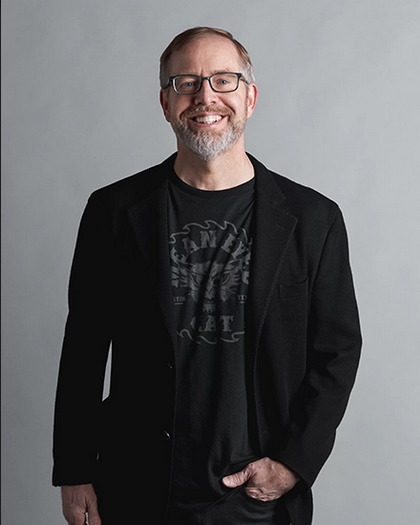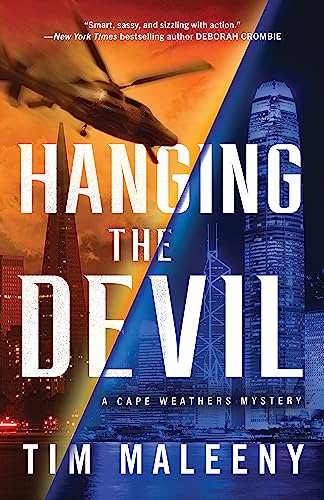 Tim Maleeny is author of the award-winning Cape Weathers series of mysteries (Greasing the Piñata, Beating the Babushka, Stealing the Dragon, Boxing the Octopus and now Hanging the Devil) and the standalone thriller Jump.
Tim Maleeny is author of the award-winning Cape Weathers series of mysteries (Greasing the Piñata, Beating the Babushka, Stealing the Dragon, Boxing the Octopus and now Hanging the Devil) and the standalone thriller Jump.
A New Jersey native, he grew up in a house filled with classic pulp mysteries and began writing crime fiction when he moved to San Francisco, where his proximity to Chinatown inspired many of his early stories. Tim Maleeny’s short fiction appears in several major anthologies and has won the prestigious Macavity Award for best story of the year.
These days he lives in New York, where he writes novels and also works for a global marketing and communication firm.
Ed Battistella: Congratulations on Hanging the Devil. Cape Weathers is one of my favorite characters. How do you come up with such great dialogue?
Tim Maleeny: Thanks, Ed, this has been an incredibly fun series to write, so I’m always thrilled when readers connect with the characters. I think of dialogue as action, no different than a car chase or a gunfight, with each character using their voice to gain an advantage, divert suspicion or bring the temperature down in an overheated situation. I also read constantly and watch several movies a week, often rewatching favorite films to listen for syntax and rhythms of speech, because hearing distinct voices can sharpen your own writing when you want unique characters who don’t sound like anyone else. Once I’ve drawn the characters clearly and know their backstory it’s hard to get their voices out of my head, so the dialogue comes naturally as your characters start to collide.
EB: Some things in this book had me going “Wow, could that be real?” Genetically engineered macaques? State-sponsored art theft? Ninjas with cloaking devices? There are all made up. Or are they?
TM: Believe it or not, all the crimes are based on actual events, with the exception of the helicopter heist at the opening of the book, which is plausible but something I made up. A number of the museum break-ins referenced in the rest of the novel did occur, and some experts in the art community suggested a state-sponsored connection at the time that was never proven or pursued, for obvious political reasons. As for gadgets and tech twists, such as genetically engineered monkeys, a quick online search shows similar experiments were conducted a few years ago, along with some unsanctioned tests involving gene splicing of human DNA, which is both disconcerting and bizarre, so I decided to bring a bit of Mary Shelley to the mystery world, with a touch of Orwell added for good measure.
EB: Your books are very character-driven, and you seem to be able get in the heads of everyone from Russian gangsters or the orphaned Chinese girl, Grace? How do you get in character’s heads?
They say reading fiction increases empathy, so think of writing as an exercise in building empathy one character at a time. If you can’t personally relate to—or channel—your characters, then you need to do more homework until they appear fully three-dimensional on the page.
I spend a lot of time building a backstory for each character, then live with them for a while before I start writing. Characters’ actions are an extension of their personalities, so I usually know how they’ll react to any situation, but if one of them says or does something that feels inauthentic, I catch it during the edit of the first draft. I know I’ve gotten it right when I feel the emotional highs and lows my characters are going through—then I figure I must be inside their heads because they’re tugging at my heart.
 EB: Are Russian gangsters hooked on America’s Got Talent?
EB: Are Russian gangsters hooked on America’s Got Talent?
TM: I am not at liberty to discuss the fandoms of Russian gangsters, but why wouldn’t they be into AGT? It was either that or The Voice, and I figured professional criminals would want more drama in their television shows.
EB: I always enjoy the signature jump cuts you use between chapters. Do you ever get stuck on a jump?
TM: I heard a great piece of advice when I first started writing novels, which was to begin the next chapter as soon as you finish the one you’re working on—do not close the laptop or take a break. In other words, when a chapter is finished, force yourself to write the opening line of the next chapter, so the next day you’re not staring at a blank page. As a result, the jump cuts are a natural way of writing for me, to keep the pages turning, as opposed to a technique added after the fact to link the story together.
The only challenging part of this comes when—during the editing process—I decide to change the order of events and move chapters around. Then I have to take a step back and rework how each scene flows seamlessly into the next, but what mystery writer doesn’t love a good jigsaw puzzle?
EB: Will we be seeing more of ex-Interpol agent Maria Diaz and young Grace in future books?
TM: My three non-committal answers are: I hope so; probably; almost definitely.
Grace is clearly an important character, not only in her own right but also in the context of Sally’s story arc, as Sally tries to protect Grace from the childhood trauma she experienced at the hand of the Triads.
Maria is an intriguing character, whose role expanded as the story developed. Her relationship with Cape walks the line between collaboration and flirtation, and as a fan of The Thin Man and The Thomas Crown Affair, it will be fun to see if they maintain a healthy balance between two very strong personalities. I wouldn’t mind seeing her again, and neither would Cape.
EB: What’s next for Cape and Sally Mei?
TM: The black market for stolen art was an area I hadn’t explored before, and my research for Hanging the Devil uncovered all sorts of connections to other global syndicates involved in criminal mischief. I find the best way to cast a light into dark corners is to make the stories as fast and fun as possible, so readers enjoy the ride but bring something back that will stay with them, maybe even give them a fresh perspective on what’s happening behind the façade of our daily lives. That’s why all the Cape and Sally adventures begin as local crimes but quickly expand to the scope of a global thriller. If you pull on a loose thread hard enough, as they always do, eventually you’ll untangle the rest of the mystery.
EB: Thanks for talking with us. I’m going back to reread Stealing the Dragon.
TM: Thanks, Ed, always great to catch up. Enjoy the underground tour of Chinatown in Stealing the Dragon; glad Cape and Sally have kept you coming back for more!

 Follow
Follow